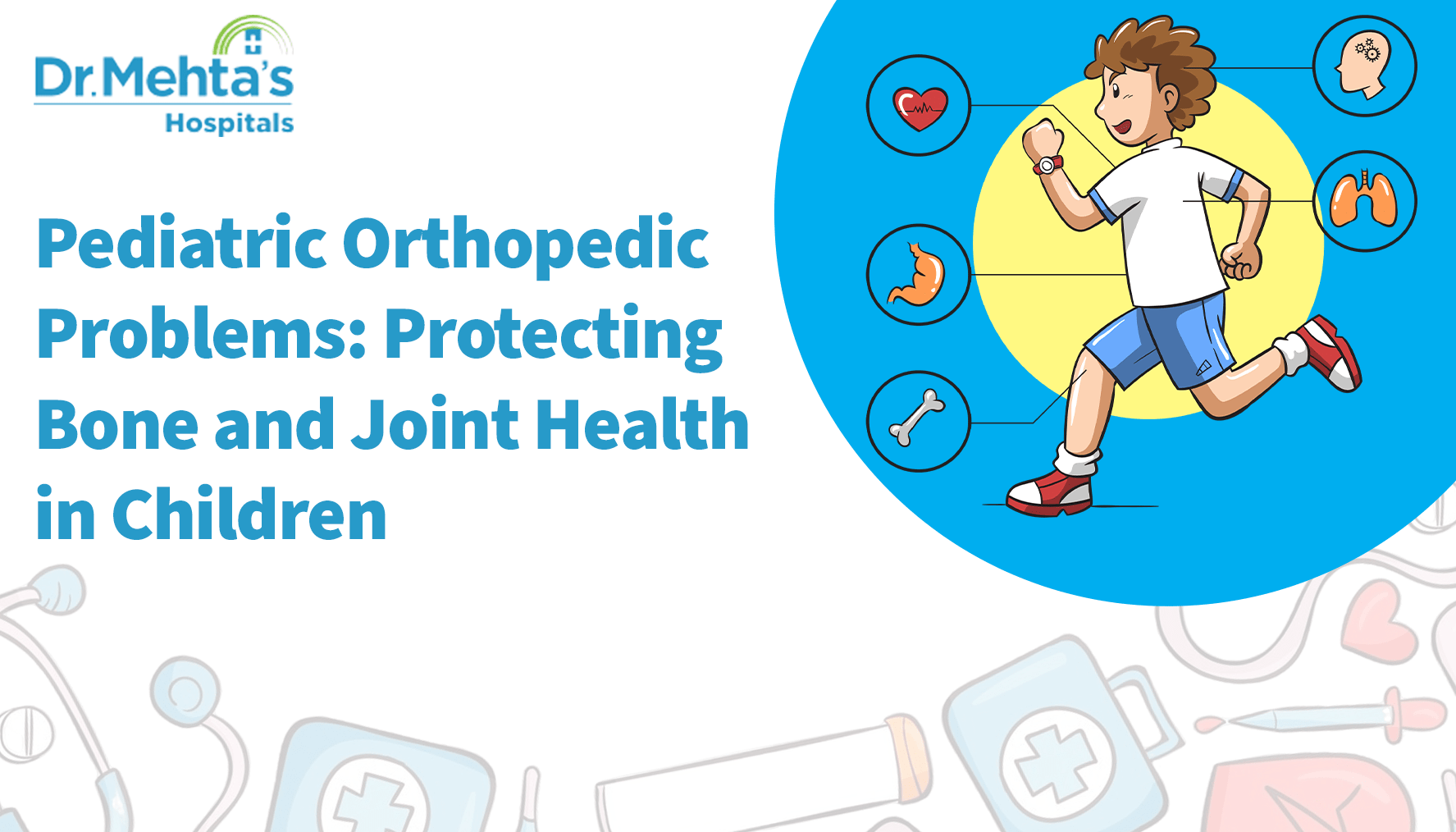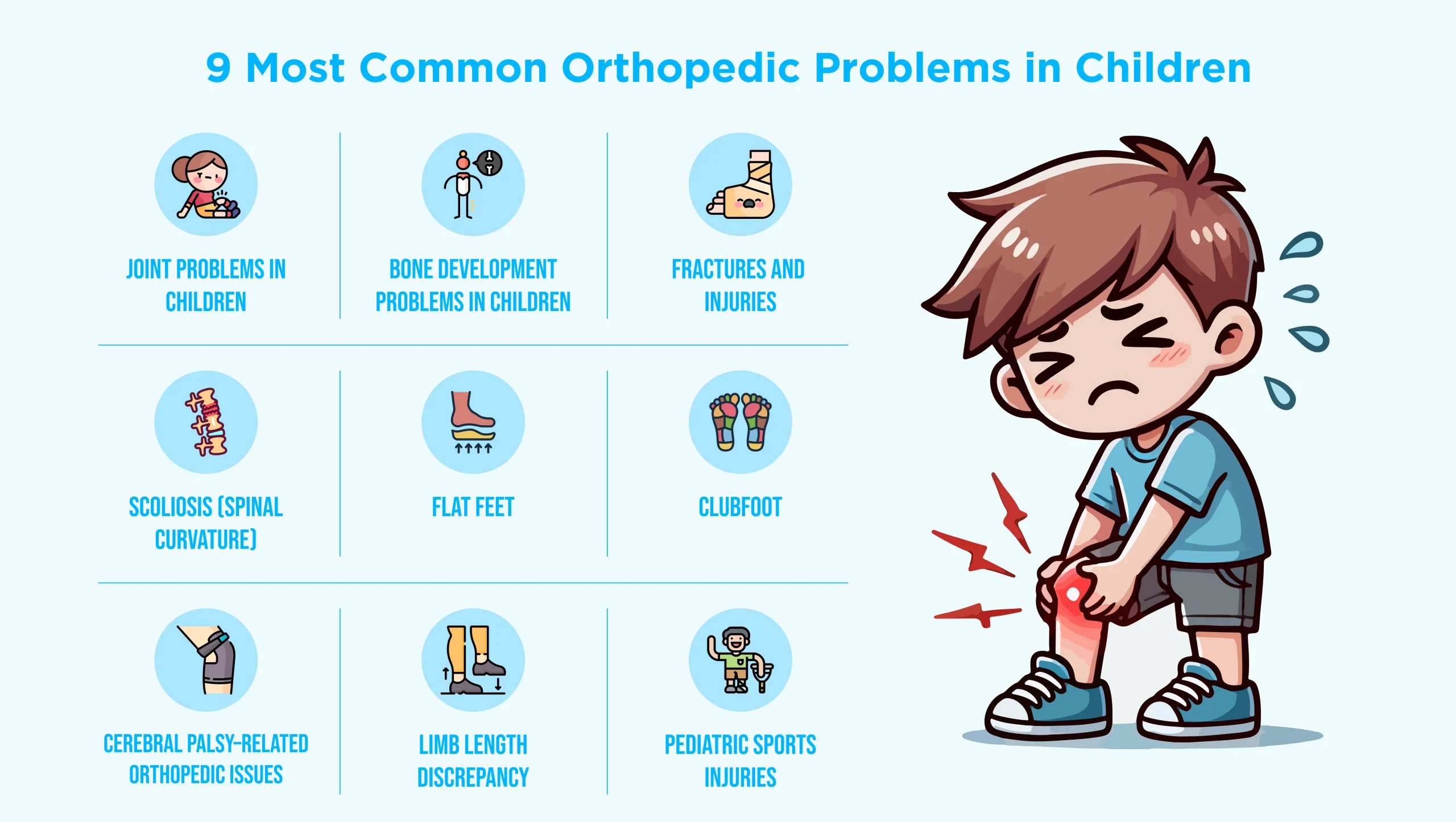Table of Contents

A healthy child’s strong bones and flexible joints form the foundation of an active lifestyle.Children rely on their musculoskeletal system in their daily lives, whether in learning to walk or in sports. However, like adults, children too can develop orthopedic issues that need timely care. The good news is that most conditions can be managed effectively with early treatment.
Our pediatric orthopedic specialists combine advanced expertise with compassionate care to help children walk confidently and grow strong.Get to know more about our Pediatric and Children’s Services at Dr. Mehta’s Hospitals.
Childhood is a crucial stage for bone growth and development. Bones contain growth plates that determine height and posture, while joints provide stability and movement. Even minor injuries or anomalies left unattended can impact long-term development.
Despite the relative prevalence of congenital musculoskeletal issues (between 2.5 and 3.5 percent among infants at birth), the number of rural locations with adequate data on the topic is minimal.
With an early correction of an orthopedic problem in pediatrics, parents can be sure of the mobility of their child, their strength, and confidence in the years ahead.

There are a multitude of orthopedic conditions that children may encounter that may be present at birth or may develop over time. Most of these can be managed with timely medical care and family support. Here are nine of the most common orthopedic problems seen in children.
Joint conditions such as juvenile arthritis, hip dysplasia, or alignment issues can be considered as joint problems in children that can impact their mobility. These may happen because of an autoimmune response, genetic predisposition, or changes in growth. Early diagnosis enables children to be active and avoids complications in the long term.
There are also issues in bone formation that may occur because of a lack of nutrients, including vitamin D or calcium. Because children still have growing bones, appropriate nutrition and healthcare instructions are critical in averting and treating these pediatric orthopedic issues.
One of the most frequent reasons why children go to orthopedic clinics is fractures. Children have softer bones that are more prone to breaking, whether due to playground accidents, cycling accidents, or even sports. Fortunately, most fractures in children heal quickly and completely as they grow. For expert care, you can consult an experienced orthopedic doctor in Chetpet.
Scoliosis is described as an abnormal oblique curvature of the spine, which is usually apparent in adolescence. Mild cases can be overlooked, but in more severe cases, posture can be influenced. Monitoring and treatment by a children’s orthopedic specialist at an early age prevents progression.
Flat feet develop when the arches of the feet fail to form well, and in some cases, they may be painful when standing and running. Although common in younger children and often self-correcting, persistent cases may need guidance, supportive footwear, or physiotherapy. For proper evaluation and treatment, you can consult a trusted orthopedic specialist in Velappanchavadi.
Clubfoot is a congenital condition in which the foot is turned inwards or downwards. Most children with clubfoot can walk normally in adulthood with early intervention (e.g., casting, braces, or minor surgery), preventing long-term restrictions. It affects about 1 to 2 in every 1,000 live births, making it one of the most common childhood deformities.
Cerebral palsy may cause muscle stiffness, contractures, or bone misalignment in children. These may influence posture and movement, but through rehabilitation, physiotherapy, and supportive care, many children have better mobility and independence.
In some children, there might be a discrepancy in the length of the arm or leg, and this is referred to as limb length discrepancy. Among the causes are birth defects, infections, or growth plate injuries. Specialists are able to offer treatments that guarantee greater balance and comfort in most cases.
Sports-related injuries such as sprains, strains, and stress fractures are becoming more prevalent in children. Overtraining, improper techniques, or lack of protective gear can contribute. Prevention involves teaching safe playing and taking a break in between activities. In case of urgent needs, families can rely on 24/7 emergency care in Chennai for immediate medical attention.
Seek advice from a children’s orthopedic specialist if your child:
Our staff of competent professionals in the Velappanchavadi Campus offers specialized attention to widespread orthopedic issues in children. Parents can consult experienced doctors like Dr. Thangavelu. S, a highly respected best pediatrician in Chennai, or Dr. Gowrishankar. N. C, a trusted child specialist in Chennai, for personalized care and guidance.
Orthopedic disorders affect children more than most parents would believe, and when these disorders are identified early and treated, children can live healthy and active lives.Whether it’s joint issues, bone problems, or injuries, the best super multispeciality hospital in Chennai combines medical excellence with compassionate care. With your assistance, we support your child in establishing a solid platform for life.
Table of Contents
Recent Post
About us
Dr. Mehta’s Hospitals is a leading multispecialty hospital in Chennai with over 90 years of excellence. With 400+ beds and 80+ specialties, its Chetpet and Velappanchavadi centers offer advanced, state-of-the-art, compassionate care under one roof.
Chetpet Contact Details
Velappanchavadi Contact Details
Feel free to ask your queries on
Our Specialities
About us
Dr. Mehta’s Hospitals is a leading multispecialty hospital in Chennai with over 90 years of excellence. With 400+ beds and 80+ specialties, its Chetpet and Velappanchavadi centers offer advanced, state-of-the-art, compassionate care under one roof.
Chetpet Contact Details
Velappanchavadi Contact Details
Feel free to ask your queries on
Our Specialities
Quick Links
Center of excellence